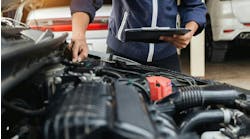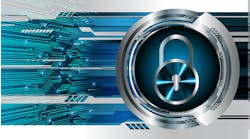ADAS is a ubiquitous term for a ubiquitous facet of the automotive repair industry.
The all-encompassing acronym covers every component in a vehicle that uses some sort of advanced technology such as cameras or sensors to help keep the driver safe in some way. Adaptive cruise control, auto lane keep assist, emergency crash detection and other features all fall under the ADAS banner.
ADAS as an industry is booming, and it’s only becoming more prominent. Data from AAA shows that at least 90 percent of new vehicles sold over the past couple of years are equipped with at least one ADAS feature. Adding on top of that, data gathered by global research firm Counterpoint shows just under 50 percent of new vehicles sold in the first half of 2022 reached Level 2 of autonomy classification.
“ADAS systems are complex and repairing and calibrating an ADAS-equipped vehicle requires very specific knowledge, skills and equipment,” says Bud Center, technical products and curriculum director for I-CAR. “We can’t stress enough the importance of proper ADAS repairs and calibrations to ensure these systems are performing as designed when the vehicle is returned to the customer.”
These systems are only going to become more prevalent as time marches on, and knowing how to calibrate and repair them will be a critical part of a collision repair shop’s ability to fully and completely repair vehicles.
Getting Started
If your shop is new to the ADAS realm, finding out where to get started can be a little overwhelming.
Tyler Peartree is the manager for the flagship location Silver Lake Auto, a four-shop MSO just west of Milwaukee. As Silver Lake was looking to enter the ADAS space about five years ago, Peartree says one member from his team took an in-person class from Autel that helped them get started.
“It was eye-opening in terms of what needed to be done,” he says.
Classes provided by organizations such as I-CAR or Autel are excellent starting points. Center says I-CAR’s listing of courses covers everything from tools and equipment needed to step-by-step calibration guides.
Most organizations will have a combination of online and in-person training options as well as dedicated staff who are there to help guide you through the early phases. I-CAR’s recently opened Chicago Technical Center also features hands-on courses using tools and equipment required by OEMs.
“There is always someone at I-CAR who is eager to help you get started,” Center says. "We’re just a click or phone call away depending on how you want to start that conversation.”
Peartree also says the courses that his team member took played a pivotal role in helping his shop get on board. Though they were already inclined to do so, the ownership group of Silver Lake Auto listened to what their technologist learned and what he recommended they pursue.
“It was all education. Once we sent our technologist to that class, he came back and educated the owners on the importance of it, and it was a pretty quick conversation after that,” he says. “It’s just that next steppingstone to stay ahead of the curve as the industry progresses."
What’s Right For You?
There are varying levels to which your shop can service ADAS-equipped vehicles. Not all shops will see the same number of ADAS-equipped vehicles, and those that see higher numbers will still see a variation in which systems they are working on.
There are around 284 million registered vehicles in the U.S. at the end of 2022, and the average age of a vehicle on American roadways is north of 12 years old. A majority of cars still don’t have ADAS features, and that can play a big role in determining what kinds of equipment your shop might need.
“Shops can start by analyzing their business to understand the vehicle years, makes and models they are most commonly repairing in their location and available in their metro area,” Center says. “With this information the shop can determine the tools and equipment that best fits their business needs.”
In some cases, it might not make sense to invest thousands of dollars into ADAS calibration equipment if it’s not something that will benefit your shop in the immediate to mid-term future. In that case, finding a third-party source to outsource your ADAS work to might make more sense. Even then, though, Center says it’s important to have an understanding of ADAS repairs to check your vendor’s work.
“It is also important to note, even if your decision is to use a third-party vendor to perform your ADAS repairs and calibrations, it is critical for the shop’s staff to be educated on ADAS so they are able to verify your vendor has calibrated the vehicle properly, documented the repair and calibration process appropriately, and the systems are performing as designed when the vehicle is returned to the customer,” he says.
In addition to knowledge and demand, Center says shops should take into account the physical space they have to work with. ADAS calibration and repair require space and specific conditions to make sure components are functioning properly. New lighting, non-reflective wall and floor coatings, level floors and more are all necessary features in a space that is used for ADAS work. If the demand is there and your shop has the space, jumping into ADAS work could be a boon for your business.
Silver Lake Auto purchased its ADAS equipment right around the same time their technologist came back from taking ADAS repair classes. They also happened to have an old dent repair building on the grounds of their flagship store that was under-utilized, which provided the perfect space to build an ADAS-specific calibration and work area.
“We did a lot of research in the beginning to make sure the building was adequate before we bought all the equipment,” Peartree says.
Their technology center has been running for about a year, and it acts as a one-stop shop for everything related to ADAS repair—techs in the center can perform calibration, modular reprogramming, sensor installation and more.
Even if your shop has the space and demand, Peartree says it will take some time to get everything up and running.
“You’re going to be in about six months of getting everything set up, get the equipment and getting your people educated,” Peartree says.
Worth the Investment
Despite the hefty up-front investment, Peartree says the commitment to ADAS has been worth every penny.
“Not only as a revenue stream, but knowing that the vehicles we repair are safe and that we’re protecting our customers’ investments and themselves,” he says. “These are collision avoidance systems. If the calibration is off, the outcome isn’t just a check engine light. The outcome could be the vehicle isn’t going to avoid an accident.“
Center says that through using resources such as I-CAR’s trainings and course offerings, it provides shops with a huge advantage over other shops that aren’t.
“They’re demonstrating their commitment to stay current with the latest repair and calibration techniques, which can increase their credibility as a leader in collision repair with customers, OEM networks and direct repair programs,” he says.
ADAS is rapidly expanding, and it’s only going to continue to be a big player in the automotive sector. Learning how to effectively repair and work with ADAS equipment is quickly becoming more than an extra service shops use to draw in customers—soon, it’s going to be an absolute necessity.
“Get into it, don’t be afraid of it and get educated on it,” Peartree says. “Jump into it as quickly as you can so you don’t get left behind.”



